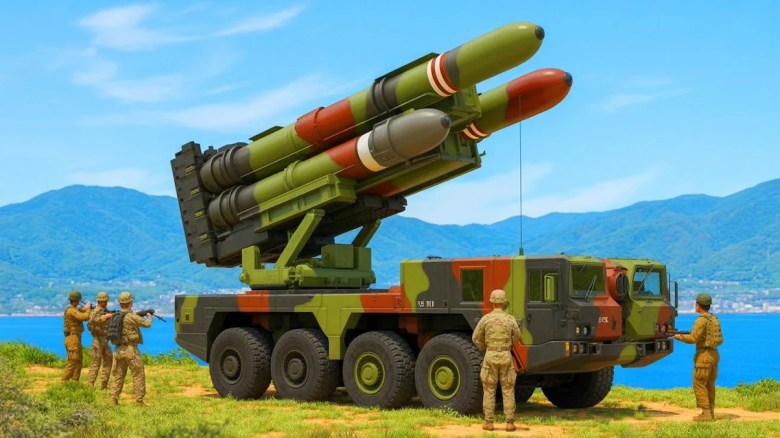Top Stories
Japan Enhances Defense with Typhon System Amid Regional Tensions

Japan has significantly bolstered its defense capabilities with the deployment of the Typhon missile system, a move aimed at enhancing deterrence amid rising tensions in the Indo-Pacific region. This development follows Japan’s efforts to remilitarize its Self-Defense Forces (JSDF) in a manner not seen since the end of World War II. In conjunction with the United States, Japan is responding to the increasing military assertiveness of China and other regional threats.
The Typhon system, designed by Lockheed Martin, is a mid-range capability missile launcher (MRC) that can deploy SM-6 and Tomahawk cruise missiles. Officially entering service with the US Army in 2023, the Typhon can target mobile objects at distances up to 499 kilometers. This capability enhances the JSDF and US Forces Japan (USFJ) ability to respond to potential threats, particularly from the People’s Liberation Army Navy (PLAN) operating in the contested waters of the East and South China Seas.
Operational Deployment and Strategic Importance
The US military has already positioned the Typhon system at Marine Corps Air Station Iwakuni in Japan following successful demonstrations during military exercises such as Exercise Resolute Dragon 25. In this exercise, US and Japanese forces engaged in joint maritime defense training, showcasing the Typhon’s capabilities in real-time operational scenarios. With the potential to engage targets on both land and sea, the Typhon enhances the operational flexibility of US and Japanese forces in a region marked by increasing military activities.
The deployment of the Typhon follows a broader strategy by the United States to strengthen its presence in the Indo-Pacific. The system’s versatility allows it to counter threats from enemy naval vessels and mobile rocket forces, which are crucial components of modern military strategy. The decision to develop the Typhon emerged from a strategic fires study conducted by the US Army’s Futures Command Research and Analysis Center in mid-2020, reflecting a proactive approach to evolving security challenges.
Regional Implications and Allied Interests
Japan’s enhanced defense posture with the Typhon system is of significant interest to several allies. Countries such as Germany and the Philippines have expressed a desire to acquire similar capabilities. Germany’s Bundeswehr is considering the Typhon to bolster its military strike capabilities, particularly in response to threats from Russia. The Typhon’s ability to reach targets in Kaliningrad, near Germany’s borders, highlights its strategic value.
The Philippines, facing challenges from aggressive Chinese naval operations, has announced plans to procure the Typhon after witnessing its effectiveness during joint military exercises. This acquisition would provide Manila with greater flexibility to respond to potential maritime provocations, thus enhancing regional security cooperation in the face of increasing tensions.
In Japan, the Typhon system represents a crucial element of the country’s defense strategy as it addresses threats from multiple fronts, including China, North Korea, and Russia. The JSDF’s capabilities will receive a significant boost, particularly as adversaries expand their medium- and long-range missile arsenals.
Additionally, Japan’s recent ratification of a defense agreement with the Philippines signals a commitment to strengthen alliances in the region, which is vital for maintaining stability across the Indo-Pacific.
As the US continues to enhance its military footprint in the region, the Typhon missile system stands as a pivotal asset in deterring aggression and ensuring freedom of navigation in the crucial maritime corridors surrounding Japan. The system’s operational deployment serves as a clear message to potential aggressors, emphasizing the resolve of both Japan and the United States in maintaining peace and security in the face of rising threats.
The Typhon missile system embodies a necessary advancement in military capabilities, enhancing the JSDF and USFJ’s readiness to confront emerging challenges in a complex geopolitical landscape.
-

 Lifestyle4 months ago
Lifestyle4 months agoHumanism Camp Engages 250 Youths in Summer Fest 2025
-

 Business5 months ago
Business5 months agoKenvue Dismisses CEO Thibaut Mongon as Strategic Review Advances
-

 Sports4 months ago
Sports4 months agoDe Minaur Triumphs at Washington Open After Thrilling Comeback
-

 Sports5 months ago
Sports5 months agoTupou and Daugunu Join First Nations Squad for Lions Clash
-

 Top Stories5 months ago
Top Stories5 months agoColombian Senator Miguel Uribe Shows Signs of Recovery After Attack
-

 World5 months ago
World5 months agoASEAN Gears Up for Historic Joint Meeting of Foreign and Economic Ministers
-

 Health4 months ago
Health4 months agoNew Study Challenges Assumptions About Aging and Inflammation
-

 Business5 months ago
Business5 months agoOil Prices Surge Following New EU Sanctions on Russia
-

 Entertainment4 months ago
Entertainment4 months agoDetaşe-Sabah Violin Ensemble Captivates at Gabala Music Festival
-

 Entertainment4 months ago
Entertainment4 months agoBaku Metro Extends Hours for Justin Timberlake Concert
-

 Top Stories5 months ago
Top Stories5 months agoRethinking Singapore’s F&B Regulations Amid Business Closures
-

 Business5 months ago
Business5 months agoU.S. House Approves Stablecoin Bill, Sends to Trump for Signature









